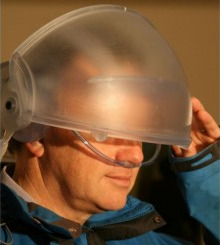Hey folks, remember virtual reality? A decade and a half ago, we were importuned with promises of virtual worlds that we could walk around in physically rather than clicking our way through with a mouse or joystick; computer-generated realities that would – in hardly any time at all – become an enjoyably commercialised take on Gibsonian cyberspace; a destination where we could work, play, learn and… er, meet new people, if you know what I mean.
 After the fad for arcade games with bulky headsets blew over (and the Lawnmower Man movie started to look dated), VR kinda dropped off all but the most geeky of radars… but there are still some clades of techo-optimists (who doubtless shoulder their way past back-issues of Mondo 2000 each morning on their way work) striving to bring the golden technodream of the early nineties to fruition.
After the fad for arcade games with bulky headsets blew over (and the Lawnmower Man movie started to look dated), VR kinda dropped off all but the most geeky of radars… but there are still some clades of techo-optimists (who doubtless shoulder their way past back-issues of Mondo 2000 each morning on their way work) striving to bring the golden technodream of the early nineties to fruition.
People like the team behind the “Virtual Cocoon”, a virtual reality headset that promises to stimulate all five senses for a completely immersive experience:
Smell will be generated electronically using a technique that will deliver a pre-determined smell recipe on-demand while the team intend to provide a texture sensation relating to something being in the mouth and tactile devices will provide touch input.
As Gizmag points out (and the accompanying photo makes plain), you’re still going to look pretty stupid while wearing the thing… and it’s probably pretty cumbersome, too. [image ganked from linked article]
Maybe it’s mean of me to snark, but I can’t help but feel this route to VR is a dead-end mud-track; with all the rapid advances in brain imaging and direct electromagnetic cortical stimulation, I suspect that when virtual reality finally arrives it won’t do so via helmets with tiny eye-screens and smell-generators, but through a comparatively subtle skull-cap of electrodes.
 Science writer Quinn Norton tests a new sense, that of always knowing what direction North is via an ankle-attached bracelet that indicates true north using vibrations from eight internal buzzers:
Science writer Quinn Norton tests a new sense, that of always knowing what direction North is via an ankle-attached bracelet that indicates true north using vibrations from eight internal buzzers: The old chestnut of fully automatic cars trundled a little bit closer with the
The old chestnut of fully automatic cars trundled a little bit closer with the  After the fad for arcade games with bulky headsets blew over (and the
After the fad for arcade games with bulky headsets blew over (and the